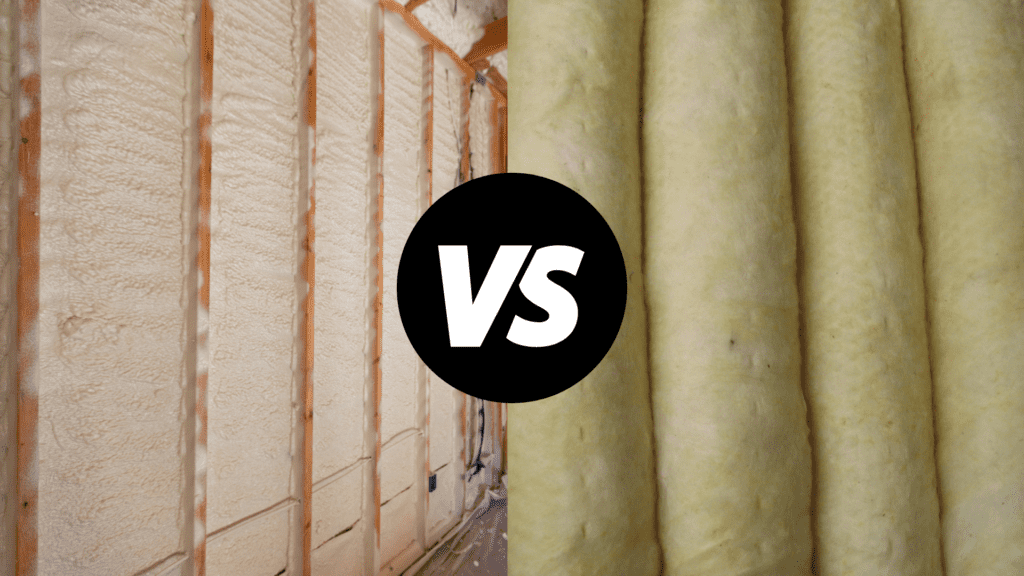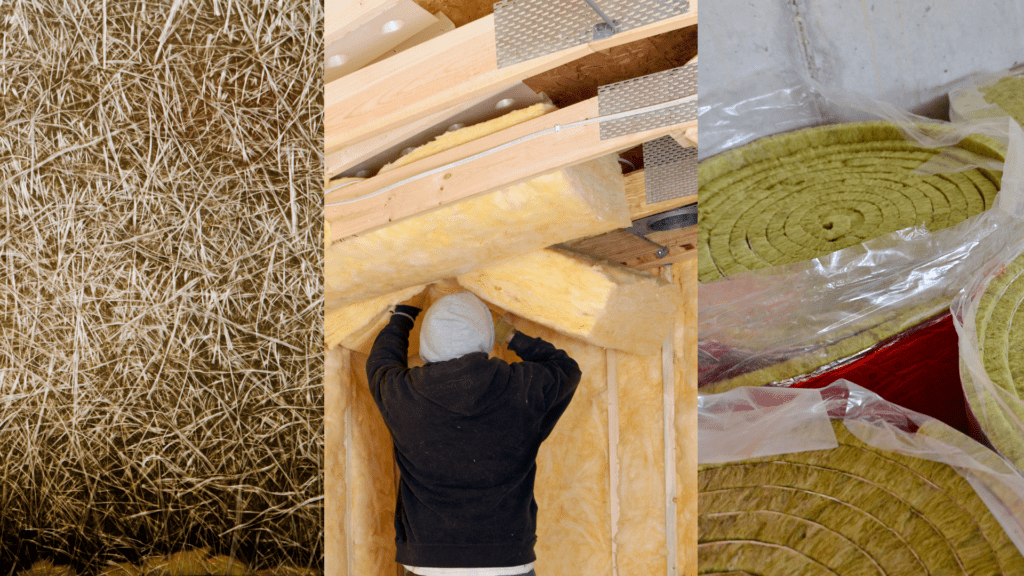Every musician knows how important soundproofing is- as well as everyone who lives near a musician! Musicians need the peace of mind to practice or play music without bothering neighbors.
Soundproofing, or reducing noise bleed from a music space, is extremely important, especially if you can address it while constructing the space. If you’re building a music studio, you can choose in-wall insulation intelligently and gain significant soundproofing.
So which is better for soundproofing: foam or fiberglass?
Fiberglass batts are better for soundproofing for building a music studio because they are cost-effective with a high STC rating. Fiberglass batts can be combined with open-cell spray insulation for an even more effective soundproof layer.
That said, it’s best to understand more about how insulation works. That will ultimately help you make the best decisions when building and insulating your space.

What You Need To Know About Soundproofing
There are some important things to know at this point, to be sure this information is relevant to you at all. First of all, “soundproofing” is commonly misunderstood, or mixed up with “sound treatment.” Especially since both involve working with sound absorption!
Everyone wishes that they could totally soundproof a space, so that no unwanted sound goes in or out. This is, unfortunately, practically impossible. To even get close would require extremely thick walls, probably concrete, which is not worthwhile for most people’s projects.
Realistically, soundproofing will significantly mitigate sound leak. But if a drummer or band is playing in the studio, then it will be pretty audible nearby. This is even true in most professional studios.
Sound treatment is a different concept. Sound treatment happens when you are working with a space that has already been constructed, and you want to control the way the sound reverberates inside. People do audio treatment for things like mixing and mastering rooms, or home theaters.
Luckily, choosing great soundproofing insulation for your walls often helps the room’s sound treatment as well!
Finally, soundproofing is far easier to handle when you are constructing a space. If the studio is already built, your options are limited, and unless you can get inside your drywall, this information is not relevant to you.
When choosing insulation for soundproofing, you have many material options. Foam and fiberglass are two common types of insulation, but cellulose and mineral wool are also great options. When choosing insulation, most people are not prioritizing soundproofing. They want that quality, but they usually care about insulating for heat and cold, as well as cost.
If you are trying to choose with soundproofing in mind, pay attention to the STC, or Sound Transmission Class. A higher number means a better rating, so try to choose the material with the highest STC number.
Here’s my article on if Acoustic foam is worth purchasing.
What is Foam: A Brief Overview
“Foam” is actually a broadly defined word, meaning any solid (or liquid!) with pockets of gas trapped inside. Practically speaking, foam refers to two types of insulation: spray foam, made of polyurethane that is sprayed on and then dries, and foam board (aka rigid foam), which is made of polystyrene (commonly referred to as “Styrofoam,” which is technically a brand name.)
Check out my article on How Effective Is Acoustic Foam?
Types of Foam
Spray foam comes in two types: open-cell and closed-cell. Closed-cell foam has several advantages, but in terms of soundproofing, open-cell foam is more effective. Foam board or rigid foam is categorized as either expanded or extruded. Expanded foam board is more effective at soundproofing than extruded.
Here are 8 reasons why acoustic foams are expensive.
What is Fiberglass: A Brief Overview
Fiberglass insulation is actually different from the hard material commonly known as “fiberglass” that is used to make things like boats and bathtubs. That material is technically “glass fiber-reinforced plastic” though it is just called “fiberglass” for short.
Fiberglass insulation is more accurately named. It is made of glass fibers, combined with a binding agent to create a fluffy and wool-like material. Fiberglass insulation is inexpensive and quite effective as insulation, so it’s very common.
Types of Fiberglass
Fiberglass insulation is sold in three forms: loose, in rolls, or batts. The batts vary in rigidity. In terms of soundproofing, the most rigid fiberglass batts are far more effective than other forms. Rigid fiberglass batts are the only form of fiberglass insulation that offers soundproofing on the same level as foam insulation.

Which is Better for Soundproofing: Foam vs. Fiberglass
This is a surprisingly hard question to answer definitively. Foam and Fiberglass can each outcompete each other, depending on what you are working with.
Overall, the absolute best option is to use rigid fiberglass batts, and if possible, to seal with a layer of open-cell spray foam. This dual-material is commonly called “flash and batt.” Rigid fiberglass batts have an STC of around 44, which is comparable to sound-absorbing mineral wool, and better than any foam insulation.
Technically, fiberglass batts shouldn’t require the open-cell spray foam for soundproofing. However, a common issue when installing fiberglass batts is open spaces between the batts. These spaces can render the insulation less effective. As such, many people recommend using open-cell spray foam insulation to fill gaps and ensure a perfect fit.
If rigid fiberglass batts are not available, then foam is usually better at soundproofing than other forms of fiberglass. Loose fiberglass insulation has an STC of around 35-39. Some types of foam boards have an STC as high as 55. However, foam is more of a “sound blocker” than a “sound absorber” which means that different sound frequencies will be absorbed unevenly. Fiberglass batts absorb sound more evenly- so even though their STC rating may seem lower, they are a better recommendation for soundproofing.
Frequently Asked Questions
Are there other types of insulation that are effective for soundproofing?
Yes. Foam and fiberglass have many overall advantages as soundproofing insulation materials. But many people prefer mineral wool (especially Roxul Rockwool, which is designed specifically as sound-absorbing wall insulation) or cellulose insulation.
Will Soundproofing Stop All Noise Leak?
No, soundproofing is an imperfect art. The idea is to make improvements, and maximize effectiveness. Totally stopping noise is technically possible, but usually completely impractical.
Is Soundproofing the Same as Audio Treatment?
No. Audio treatment, or sound treatment, means controlling the way sound is heard inside a room. Soundproofing means trying to control how much sound leaves the room. Audio treatment is much easier to do inside a room that’s already built.
Some people confuse the ideas of audio treatment and soundproofing. Audio treatment often involves building or installing individual sound-absorbing panels inside a room. These panels do not have an effect on soundproofing. Incidentally, a well-soundproofed room actually makes audio treatment easier.
Can I Soundproof a Room That’s Already Built?
Unfortunately, there’s very little you can do without modifying the construction of the room. Soundproofing should be done when constructing (or extensively modifying the construction of the room.)
One of the only effective ways to further soundproof a room that’s already been built, is to construct a “room within a room.” This is as difficult and expensive as it sounds, and has the further disadvantage of making the final space significantly smaller. However, in some cases, it’s a great option.
What Other Things Can Help Soundproof a Room?
Insulation choice is very important, but many other techniques can be used in tandem! If possible, a standalone room that doesn’t share any walls with neighbors will be far more soundproof-ed. Also, try staggered stud construction, integrating mass-loaded vinyl, floor felt underlayment and a decoupled floor.
Final Thoughts
Soundproofing a music studio or music space is certainly a big job. It’s daunting, and it’s tempting to just rush the process. However, taking your time to understand the process is so worthwhile! It’s much better to over-prepare than to wish you had done more.
Because it is much more challenging to improve the soundproofing of an already-built space, doing it right the first time is so much more effective. Always have fun, and feel the joy of the music!
References
- https://www.sbcmag.info/news/2017/jul/noise-control-performance-comparison-between-batt-annD-foam
- https://www.sbcmag.info/news/2017/jul/noise-control-performance-comparison-between-batt-anD-foam
- https://bettersoundproofing.com/best-soundproofing-insulation/
- https://www.infobloom.com/what-are-the-pros-and-cons-of-polystyrene-insulation.htm
- http://www.solar365.com/green-homes/insulation/fiberglass-insulation-pros-cons
- https://www.knaufnorthamerica.com/en-us/blog/fiberglass-vs-spray-foam-which-is-best
- https://virginiafoam.com/what-you-should-know-about-the-flash-and-batt-insulation-system/
- https://www.greenbuildingadvisor.com/article/the-flash-and-batt-method
Recent Posts
QuickTime is a vital app for many Mac users, and if you’ve recently bought a new microphone, you might wonder how to use it optimally. QuickTime cannot record audio content if it doesn’t have...
Every microphone leaves a unique signature on the quality of its output. If you’re a podcaster trying to melt your way into your audience’s hearts, a muddy, distorted recording won’t cut it....
